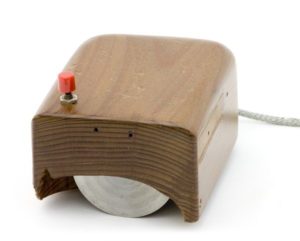
In the early 1960s, Douglas Engelbart established a lab at Stanford Research Institute (now SRI International), aiming to enhance human intellect through technology. His laboratory prototyped key aspects of modern computing, such as the groundbreaking oNLine System, which pioneered word processing, hyperlinks, online collaboration, and more.
Engelbart’s vision for a partly graphical interface required a pointing device. Computer engineer Bill English designed the first computer mouse in 1964, crafted from redwood by the SRI machine shop. Patented in 1970, the device revolutionized computer interaction, freeing users from costly light pens. Its legacy remains a foundational element of modern computing.

The SRI mouse replica. Can you tell the difference?
Until now, the mouse on display in CHM’s Revolution exhibit was a faithful replica created by the original maker, Bill English. It will be replaced by the original mouse.
In 1968, Engelbart and his staff put on what became known as “The Mother of All Demos” to showcase what they had been working on at the lab to computing professionals at a conference in San Francisco.
The demo presented many of the features of modern computing for the first time, including live videoconferencing, word processing, windows, document sharing, and of course the mouse. Engelbart describes how the mouse works in the video below (timecode, 2:36).
Excerpt from Doug Engelbart’s “Mother of All Demos,” December 9, 1968.
Bill English and Doug Engelbart discuss the mystery of the mouse’s name, its competitors, and the design, testing, and experiments with the mouse at SRI thirty years later.
After leaving SRI, Bill English went to work at Xerox’s Palo Alto Research Center (PARC) in 1971, where he developed a ball mouse for their groundbreaking early personal computer, the Alto.
Can you find the mouse in the 1979 Alto commercial?
After a well-documented visit to SRI by Steve Jobs and other Apple engineers, a mouse was developed to accompany the Lisa and Macintosh (pictured) computers. Learn more about the commercialization of these groundbreaking computers here.
A 1983 ad for the Lisa read: “To tell Lisa what to do, all you have to do is point to the appropriate picture using a clever palm-sized device called ‘a mouse.’ As you move the mouse on your desk, the pointer moves on Lisa’s screen.”
See the ad in the collection.
You can get lost exploring down a rabbit (mouse?) hole in the exhibit, which has lots of information about the mouse, including the patent drawings for the original mouse and early trackball devices.
Check out the online exhibit section here.
CHM’s collection has a virtual infestation, with over 1,000 mouse-related items. See them here. A couple of the stranger artifacts include:
In 2011, Swiss manufacturer Pat Says Now’s computer mouse won the Guinness World Record for the most expensive computer mouse. Cast from 18 carat white gold and set with 59 individual diamonds, the mouse retailed for £16,200 ($26,000).

Photo courtesy of Pat Says Now.
In the 1990s, the Macintosh Users Group of Corvallis apparently put out a newsletter called Mouse Droppings. Hmm . . .

Doug Engelbart using his mouse.
In a 2001 panel discussion, Engelbart described the mouse as “an evolutionary tool.” He went on to explain: “The mouse is sort of like giving a person good contraction and mobility … like a surfboard or guys using a skateboard—it’s just magic to watch how they can work.”
We couldn’t agree more.
Next time you’re at CHM, stop by and say “hi” to the original SRI mouse.